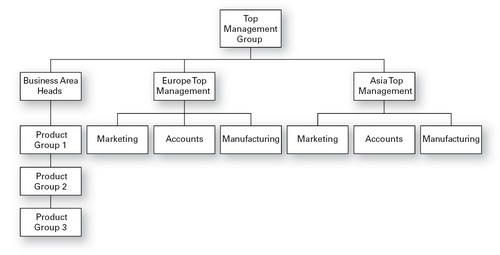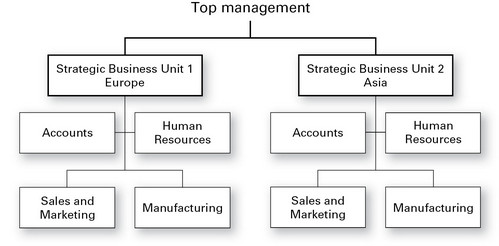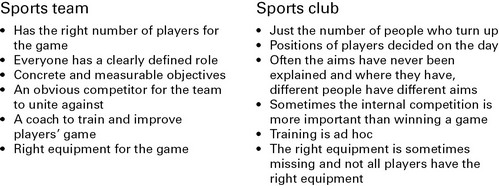The 30 Day MBA (26 page)
Authors: Colin Barrow

FIGURE 4.5
 Â
Matrix organization chart

The aim of a matrix structure is to ensure that all key areas in an organization have a line manager responsible for championing them. There is still the possibility for conflict of interest. For example, the person responsible for a product group may try to get more attention for their product in a particular market than it really warrants. In theory, the managers in matrix organizations are senior enough to iron out their differences. That is not always the case in practice and in such cases their mutual boss has to resolve the issue.
Strategic business unit (SBU)
SBUs (
Figure 4.6
) are in effect separate enterprises with full responsibility for their own profit or loss. They may themselves be organized in any one of the above structures. If they don't have their own specialist staff function, they may buy it in from the parent company when required. This maintains the concept of full profit accountability.
FIGURE 4.6
 Â
Strategic business unit organization chart

SBUs are further divided into those that simply have control over current revenue and expenditure and those âinvestment centres' that can make capital expenditure decisions such as setting up a new plant, investing in research and development or buying up competitors.
Succession planning
No general would fight a battle without having a reserve force ready to plug gaps that appear in the front line or are caused by casualties in key staff. Perhaps the most spectacular military example was the rapid deployment of Montgomery to head the 8th Army when Churchill's own preferred candidate, âStrafer' Gott, was killed flying back to Cairo.
For business and other organizations this reserve is usually limited to the process of identifying future potential leaders to fill key positions when staff leave or are themselves promoted. A subsidiary but nonetheless important role of any organization chart is to facilitate this planning.
Elements to consider in this area include:
- broadening existing managers' competences by lateral moves in the organization;
- training and development across a wider skill base than is required for current roles;
- having a database of outsiders who can rapidly be approached by head hunters (specialist recruitment consultants) when the need arises.
Teams
Teams are the component parts of a business's structure and their effective creation and operation are a key way to get exceptional results from an organization. A group of people, even if they work together, are not necessarily a team. Look at
Figure 4.7
, which compares some of the characteristics of a sports team with those of a random collection of people that meet for a game. You can see immediately what needs to be done to weld people into a team.
FIGURE 4.7
 Â
Groups are not the same as teams

Successful teams have certain features in common. They all have strong and effective leadership; clear objectives; appropriate resources; the ability to communicate freely throughout the organization; the authority to act quickly on decisions; a good balance of team members; the ability to work collectively; and a size appropriate to the task.
Team types
Teams can be made up of anything from 5 to 20 people. Anything above 20 is usually too unwieldy and will take up more resources than an organization can afford to devote to one aspect of the business.
Business teams
These are a group of people tasked with managing functions and achieving specific results over the longer term. In this example there are three of these, covering sales, administration and warehouse/dispatch. So, for example, the sales team is expected to meet sales targets and the dispatch team to get goods to customers on time. In practice, every firm will have its own definition of business functions.
Project teams
These are often cross-functional, made up of people from different areas. These can be assembled for any period of time to look at a particular project. In this example we have assumed that each of these teams has been asked to look at how each function could be made more efficient. The value of having someone from other functions in these teams is to ensure that too parochial a view is not taken.
Taskforce teams
This is a short-term body put together quickly to look at one narrow issue or specific problem. For example, if you proposed changing your working hours a taskforce could look at the implications for everyone inside and outside the firm and report back. Then a decision based on the best information, provided by people most affected by the change, can be made.
Team roles
However talented the soloists are in an organization, in the end it is orchestras that make enough ânoise' to make things happen. But teams don't just occur naturally. The presumption that people are going to work together is usually a mistake. Chaos is more likely than teamwork.
Cultures in businesses have very different pedigrees and can pull the organization in very different directions. Take one successful new internet business for example, where people came from financial services, retail and more recently technology. The company's roots were in financial services. Their competitors were banks and brokerage firms and their employees had moved around the sector in search of the ultimate accolade, to become a vice-president. The focus was inwards towards âhierarchy and title'. Their second cohort of employees came from retailing, the staff of their one-time expanding branch network. For retailers the focus is outwards towards the customer. Their success was measured in the market and the best salespeople had the greatest respect and power. The third group, and the most recent, was the technologists. For these people success was measured by technical expertise. Titles were irrelevant and their main concern was for the completion of the project. Their loyalty was not to the hierarchy but to the principles of the project itself, and to their team.
Putting people with disparate cultures into teams because of their particular professional or job skills may not be effective. If the team is to function effectively, the balance of behavioural styles has to mesh too. These are the key roles identified by Meredith Belbin while a Research Fellow at Cranfield (
www.belbin.com
), which need to be taken if a team is to work effectively (there are other methods of categorizing team roles):
- Chairman/team leader. Stable, dominant, extrovert. Concentrates on objectives. Does not originate ideas. Focuses people on what they do best.
- Plant. Dominant, high IQ, introvert. A âscatterer of seeds' who originates ideas. Misses out on detail. Thrustful but easily offended.
- Resource investigator. Stable, dominant, extrovert and sociable. Lots of contacts with the outside word. Strong on networks. Salesperson/diplomat/liaison officer. Not an original thinker.
- Shaper. Anxious, dominant, extrovert. Emotional and impulsive. Quick to challenge and to respond to a challenge. Unites ideas, objectives and possibilities. Competitive. Intolerant of woolliness and vagueness.
- Company worker. Stable, controlled. A practical organizer. Can be inflexible but likely to adapt to established systems. Not an innovator.
- Monitor evaluator. High IQ, stable, introvert. Goes in for measured analysis, not innovation. Unambiguous and often lacking enthusiasm. But solid and dependable.
- Team worker. Stable, extrovert, but not really dominant. Much concerned with individuals' needs. Builds on others' ideas. Cools things down when tempers fray.
- Finisher. Anxious introvert. Worries over what could go wrong. Permanent sense of urgency. Preoccupied with order. Concerned with âfollowing through'.
These are the five essential elements to establishing and running effective teams.
Balanced team roles
You have to start building a team by recognizing that people are different. Every team member must not only have their âtechnical' skills such as being an accountant or salesperson. They must also have a valuable team role. Experts in team behaviour have identified the key team profiles that are essential if a team is to function well. Any one person may perform more than one of these roles. But if too many people are competing to perform one of the roles, or one or more of these roles are neglected, the team will be unbalanced. They will perform in much the same way as a car does when a cylinder misfires.
Shared vision and goal
It is essential that the team has ownership of its own measurable and clearly defined goals. This means involving the team in business planning. It also means keeping the communications channels open as the business grows.
The founding team knew clearly what they were trying to achieve and as they probably shared an office they shared information as they worked. But as the group gets larger and new people join, it will become necessary to help the informal communication systems to work better. Briefing meetings, social events and bulletin boards are all ways to get teams together and keep them facing the right way.
Have a shared language
To be a member of a business team, people have to have a reasonable grasp of the language of business. It's not much use extolling people to improve return on capital employed or reduce debtor days if they have only the haziest notion of what those terms mean, why they matter or how they can influence the results. So you need to develop rounded business skills across all the core team members through continuous training, development and coaching.
Compatible personalities
While having different Belbin team profiles is important, it is equally vital to have a team who can get on with one another. They have to be able to listen to and respect other people's ideas and views. They need to support and trust one another. They need to be able to accept conflict as a healthy reality and work through it to a successful outcome.
Good leadership
First-class leadership is perhaps the most important characteristic that distinguishes winning teams from the also-rans. However good the constituent parts, without leadership a team rapidly disintegrates into a rabble bound by little but a pay cheque. (See later in this chapter for more on leadership.)
CASE STUDY
 Â
Cisco Systems: running the virtual team
Cisco, a Fortune 100 transnational and the worldwide leader in providing hardware, software and service offerings that provide networking solutions for the internet, is always striving to build lower costs into its product offerings. Unsurprisingly the company is an enthusiastic consumer of its own products. They use wikis, social networking and other low cost, web-based collaboration services, all enabled by their routers. But it is TelePresence, developed over a seven-year period while economies were booming, that
Cisco believes to be a long-term winner. TelePresence is a video conferencing system that captures subtle nuances such as body language and tone of voice and gives users the real feeling of being in the same room together. Cisco use TelePresence as a key resource for their international team of virtual expatriate managers. Some 5,500 TelePresence meetings take place throughout Cisco worldwide every week, enabling their key staff to operate out of almost any location in any country. As well as improving the efficiency of their expat operations it has enabled them to cut their annual travel budget by US $290 million (£175 million) â just over 50 per cent.
